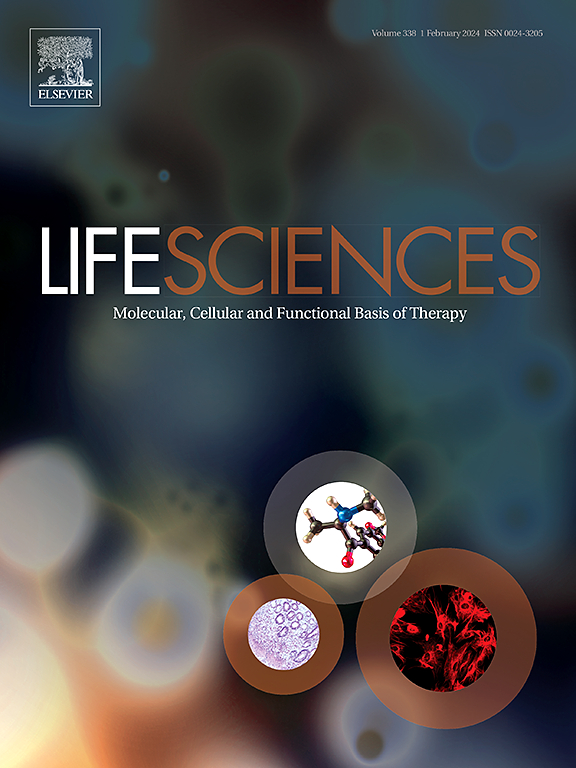脑卒中后高血糖异常调节神经细胞帽依赖性翻译。
IF 5.2
2区 医学
Q1 MEDICINE, RESEARCH & EXPERIMENTAL
引用次数: 0
摘要
目的:卒中后高血糖已被证明会阻碍功能恢复。早期的研究结果表明,帽依赖性翻译调节因子4E-BP1在高血糖状态下是有害的上调。本研究旨在验证高血糖缺血性再灌注损伤(I/R)影响脑卒中后正常蛋白翻译的假设。方法:将大鼠初级皮质神经元(pcn)暴露于氧葡萄糖剥夺(OGD)中,然后在再氧化时增加葡萄糖浓度(0,5,10,25 mM)。在体内,成年大鼠进行2小时短暂性大脑中远端动脉闭塞(t-dMCAO)和高血糖再灌注。关键发现:在PCN培养中,高葡萄糖水平在24 h I/R时破坏了正常的神经突生长,严重抑制了40S核糖体亚基中S6核糖体蛋白丝氨酸235/236残基的磷酸化。这与大量缺氧诱导因子-1α (HIF-1α)不稳定和持续血管内皮生长因子(VEGF)一致。我们的免疫印迹结果表明HIF-1α的稳定和AMPK的激活依赖于葡萄糖的可用性。高于生理水平的葡萄糖浓度增加,诱导了4E-BP1、eIF-4E低磷酸化形式的转变,导致eIF-4E的有效性和有效性降低,而eIF-4E是将40S核糖体亚基募集到mRNA 5'端的关键。体内t-dMCAO大鼠脑免疫染色显示,与正常血糖动物相比,高血糖大鼠脑皮层边缘组织中磷酸化的4E-BP1,特别是56核糖体蛋白显著降低。意义:这些发现表明高血糖I/R损伤与脑卒中后帽依赖性翻译失调之间存在显著关联。进一步的功能得失实验可能阐明调控HIF-1α/翻译在高血糖I/R损伤中的潜在治疗靶点。本文章由计算机程序翻译,如有差异,请以英文原文为准。

Poststroke hyperglycemia dysregulates cap-dependent translation in neural cells
Aims
Post stroke hyperglycemia has been shown to deter functional recovery. Earlier findings have indicated the cap-dependent translation regulator 4E-BP1 is detrimentally upregulated in hyperglycemic conditions. The present study aims to test the hypothesis that hyperglycemic ischemic reperfusion injury (I/R) affects normal protein translation poststroke.
Methods
Rat primary cortical neurons (PCNs) were exposed to oxygen glucose deprivation (OGD) followed by increasing glucose concentration (0, 5, 10, 25 mM) at reoxygenation. In vivo, adult rats were subjected to two hours transient distal middle cerebral artery occlusion (t-dMCAO) and hyperglycemic reperfusion.
Key findings
In PCN cultures, high glucose levels impaired normal neurite growth at 24 h I/R where it drastically depressed S6 ribosomal protein phosphorylation at serine 235/236 residues in 40S ribosomal subunit. This concurred with substantial hypoxia inducible factor-1α (HIF-1α) destabilization and sustained vascular endothelial growth factor (VEGF). Our immunoblotting findings indicated HIF-1α stabilization and AMPK activation rely on glucose availability. Incremental glucose concentrations above the physiological levels, induced a shift towards 4E-BP1, eIF-4E hypo-phosphorylated forms leading to reduced eIF-4E availability and efficacy, as the key to recruit the 40S ribosomal subunit to the 5′ end of mRNA. In vivo, immunostaining of t-dMCAO rat brains showed remarkable decrease in phosphorylated 4E-BP1 and particularly s6 ribosomal protein in the marginal cortical tissue of hyperglycemic compared to normoglycemic animals.
Significance
These findings suggest a remarkable association between hyperglycemic I/R injury with dysregulated cap-dependent translation poststroke. Further loss/gain of function experiment may elucidate the potential therapeutic targets in regulation of HIF-1α/translation in hyperglycemic I/R injury.
求助全文
通过发布文献求助,成功后即可免费获取论文全文。
去求助
来源期刊

Life sciences
医学-药学
CiteScore
12.20
自引率
1.60%
发文量
841
审稿时长
6 months
期刊介绍:
Life Sciences is an international journal publishing articles that emphasize the molecular, cellular, and functional basis of therapy. The journal emphasizes the understanding of mechanism that is relevant to all aspects of human disease and translation to patients. All articles are rigorously reviewed.
The Journal favors publication of full-length papers where modern scientific technologies are used to explain molecular, cellular and physiological mechanisms. Articles that merely report observations are rarely accepted. Recommendations from the Declaration of Helsinki or NIH guidelines for care and use of laboratory animals must be adhered to. Articles should be written at a level accessible to readers who are non-specialists in the topic of the article themselves, but who are interested in the research. The Journal welcomes reviews on topics of wide interest to investigators in the life sciences. We particularly encourage submission of brief, focused reviews containing high-quality artwork and require the use of mechanistic summary diagrams.
 求助内容:
求助内容: 应助结果提醒方式:
应助结果提醒方式:


